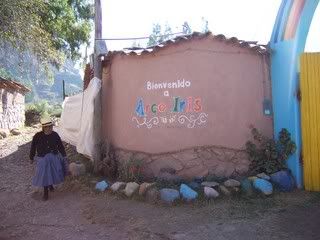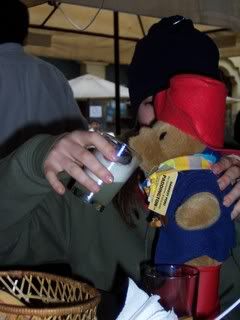Have a look at this post over at Life in Translation, where blogger Mago comments on false friends and traps for unwary translators by examining the translation between French, Spanish and English of a feminine hygiene product. Excellent stuff!
Back to work bliss
Well, I’m back (and in dire need of a holiday to recover 🙂 ) It was a great few weeks, the culmination of an 18 month project I’ve been working on and I can’t quite believe it’s (almost) all over.
I led a group of 3 other adults and 16 teenagers out to Urubamba, Peru, where we worked with a fantastic charity called Kiya Survivors for 2 weeks. We planned and fundraised the whole project ourselves from scratch and as we’re all volunteers, the sense of satisfaction has been enormous. It was a LOT of work and the learning curve was very steep – I reckon I’ve easily spent an average of one working day a week on it, not including the 4 weeks unpaid leave I’ve just had 🙂 (Personally, there’s no way I could have managed it without the freedom and flexibility of being freelance – although there are those that do manage it!).
A girl’s gotta balance her “me-lance”life with something, right?!
Out of office notice
Credit where credit is not due?
Apparently, I’m an e-expert…
Our research suggests the following:
e-experts are well above average in their understanding, exploration, and use, of the digital universe. An active online consumer, you really appreciate the benefits of digital devices to your life, which includes work, leisure, keeping in touch, shopping, travel, and entertainment. You are keen to share your enthusiasm, and are already thinking about your next e-nlivening e-xperience!
…but I’m not sure appreciation, enthusiasm or even thinking comes into it – I’m just a perfectly “normal” Gen Y-er.
I’ve put a link to the survey in the right-hand column of my blog. Have a go and let me know what you think.
Shifting gears
Penelope Truck over at the Brazen Careerist is one of my favourite bloggers ever, and I’m delighted to have an opportunity to shamelessly hat tip in her direction today.
A recent post on 5 ways to be better at self promotion has useful advice for freelance translators at all levels of expertise. But a comment in point number 2 – Stay the most focused when things look the most difficult – especially caught my eye:
… it’s easy to get frustrated when things are not happening fast enough. So it makes sense that we’d try something new, to see if it might work faster.
I did this a lot while I was trying to be a freelance writer. I can write a wide range of stuff, and it took me a while to figure out the intersection of things I like to write and things I could get paid well to write. I knew a ton of opportunities in both of those categories, but I could think of very few things at the cross section of the two categories.
This is real food for thought for me. Like a lot of translators, I think, I see a definite distinction between the kind of translations I like to do but can’t afford to 5 days a week, and the kind of translation work that pays well. I’ve worked hard to move past the stage of needing to take every job that comes my way and I also feel I am well rewarded for the kind of work I do. So now my books are full, I’m keen to move on the the next stage.
I feel a re-shuffle of some sort is in order to mark this transition, but I hadn’t managed to work out just how I was going to do this. So I’ve decided to take a leaf out of Penelope’s very successful book, and work on trying to find the intersection between these two categories. It’s not an answer just yet, but at least it’s a question.
Harry Potter in Translation
The Harry Potter series of fantasy novels by J. K. Rowling have become some of the most widely read works of children’s literature in history. There are official translations from the original English into at least 67 languages, including “localised” versions for the US market from the original British English, for both the Portuguese and Brazilian markets, and into both ancient and modern Greek (unofficial versions number many more).
This means that, of the 325 million Harry Potter books sold around the world at the time of writing (2007), some 100 million copies don’t contain a single line of JK Rowling’s prose according to The Guardian. Instead, it is the job of a translator to set the tone, create suspense and humour, and give the characters their distinctive voices and accents.
In celebration of translators’ mind-boggling contribution to this global literary phenomenon, here’s my little round up of interesting facts on Harry Potter in translation:
- JK Rowling is notoriously tight-lipped about plot developments and went to great lengths to ensure that “spoilers” were not released prior to the book’s English language publication date. She wouldn’t even make information about future plot twists available in advance to her translators, which resulted in some interesting quirks in the various language versions given the clues that are sprinkled throughout the series. See this article for a discussion of some of these.
- In some countries such as Italy, the first book was revised by the publishers and re-issued in an updated edition in response to feedback from readers.
- Translations sometimes became an interactive affair – a German fan site was set up to start work on collaboratively translating the books as soon as they were released in English, and the Polish translator ran an online competition to find a snappy translation for Ripper, the name of Aunt Marge’s vicious hound.
- Food played a key role throughout the series, and Rowling herself cited this to be a strong element of her scene setting. Translators employed a range of techniques to reflect this. For example, cornflakes earned a footnote in the Chinese translation to indicate that they are eaten immersed in milk for breakfast. A former classmate of mine thought there was enough material like this to write her masters thesis on the translation of food in the Russian language Harry Potter. (Although she didn’t write it in the end – shame 🙂 )
- Spanish readers will find most names and invented words unchanged, whereas those in Brazil will find themselves closer to the Harry Potter spirit if not the name, as the translator Lia Wyler set herself the task of coining over 400 new words (I guess she was paid by the hour 🙂 )
- The spells and incantations also posed a particular challenge. Many of these were invented by Rowling and are based on Latin, so they have a certain resonance with English speakers. To create a similar effect in the Hindu version, Sanskrit was used, but translators were often forced to invent words or use transliteration.
- The environment of an English boarding school also proved difficult to translate across cultures. In the Ukrainian version, for example, the translator chose to evoke the atmosphere of an orphanage for poor children instead. The Hebrew translator however decided an Israeli audience would accept the English boarding school setting as it was, part and parcel of Harry’s fantasy world.
- Anagrams also played a key role in the novels but were not always successfully captured in other languages. Here’s an extract from Wikipedia explaining how translators dealt with the name of one of the main characters, who cropped up in several books under different guises:
Anagrams such as that of Tom Riddle’s name that appears in the second book also do not make the transition easily into other languages. Translators have sometimes altered the names in the book in order to make the anagram work in that language. Sometimes translators manage to alter only one part of the name: Tom Riddle’s middle name of Marvolo was changed to “Vandrolo” in the Hebrew edition, to “Marvoldo” in Turkish, to “Sorvolo” in Spanish, to “Marvoloso” in Slovak and to “Orvoloson” in Italian. In other languages, translators replaced the name entirely for the sake of preserving the anagram: in French, Riddle’s full name becomes “Tom Elvis Jedusor” an anagram of “Je suis Voldemort”; Dutch his name becomes “Marten Asmodom Vilijn”, an anagram of “Mijn naam is Voldemort” (My name is Voldemort); in Czech, his name is “Tom Rojvol Raddle”, an anagram of “Já, Lord Voldemort” (I, Lord Voldemort); in Icelandic his name becomes Trevor Delgome; in Swedish the name becomes “Tom Gus Mervolo Dolder”, an anagram of “Ego sum Lord Voldemort”, where “ego sum” is Latin, not Swedish, for “I am”. In Finnish his name is Tom Lomen Valedro (Ma olen Voldemort), in Hungarian the name is “Tom Rowle Denem”, which is the anagram of “Nevem Voldemort” – the ‘w’ in the name becomes two ‘v’s. These changes to the name created problems in later books: Tom Riddle should share his first name with Tom the Bartender, but this is not the case in all translations. (Accessed: 2010)
And finally, here’s where to start if you’re looking for more detailed information:
- Wikipedia has a great entry on Harry Potter in translation, including a good discussion of many of the translation issues across a range of languages. This is a good starting point on the subject.
- An excellent piece originally appeared in the journal of the Northern California Translators Association, and dealt with linguistic and cultural issues, choices faced by translators, procedural and marketing aspects, special challenges surrounding the translations, and so on. Read it here: Part 1 and Part 2.
- This site provides what appears to be a detailed comparison of Harry Potter in Chinese, Japanese, and Vietnamese translation, looking at the way chapter titles, fictitious book titles, and proper names have been translated, passages of verse and prose, and of course, the “inevitable” translation bloopers.
- Here’s an FT article where the Ukrainian, Hebrew and Danish translators speak about the impact of Pottermania on their lives.
- Interesting little Guardian article by Daniel Hahn, a noted translator himself, on some of the translation challenges posed by the Harry Potter series. I’d love to see more articles like this out there – he does a fantastic job of putting the work of the translator firmly into perspective for the layman.
- ITI’s Bulletin reproduced a particularly difficult passage from the fourth book in 13 different languages in its March – April 2003 issue, if you’re interested in carrying out a comparison yourself.
Be a Renaissance Man
Received wisdom says that if you want to make your living as a freelance translator, then you most definitely need to specialise.
But training or extensive experience in an area other than translation is not the only means of specialisation. It’s a shame that all too often, translators themselves underestimate the value of their skills. We forget that the very fact of being an experienced or highly trained translator can in itself be a form of specialisation. Welcome to the world of the multi-talented freelancer.
It’s not that it’s not worth considering a niche or USP, of course. But it’s even more important not to lose sight of what your Ideal Client is really looking for in a freelancer.
Now, my Ideal Client is looking for someone who can take the job in hand and get it done. What’s more, they’re prepared to pay (at the very least) a fair price for this. (Forget about quality – quality is a given for my Ideal Client). And once you move away from the bargain basement shoppers, this client does exist. For example, just think how many buyers of translation need to hire a translator, web designer, copywriter, proofreader and project manager. If, as a multi-talented translator, you can offer them all these skills then you represent good value for money and are offering a worthwhile service. Why not use this as a form of specialisation in itself, and hey, maybe even charge premium rates too. I’m sure it’s no coincidence that a recent survey of translators’ earnings found that those who generated the highest salaries called themselves “language professionals”, while all other categories of earners called themselves “translators” (I’ll try find the source for this another time).
This is all stuff we know, really, but seem to forget when we plan our own careers. The real question is how can we ensure we keep up our skill levels on all fronts when we decide to add to our skill sets? This blog [ed Feb 2011: blog no longer exists, link removed] offers an excellent solution to this problem by emphasising the importance of concentrating on complementary skills. As Rico puts it:
Skills that aren’t on the opposite ends of the spectrum, but right next to each other. It’s easier to focus your energies this way, because complementary skills share some common expertise.
Pick up more languages that are related to each other. Look at your interests and background and research closely related areas. Of course, you won’t be able to call yourself an expert on everything either, but then you’re not trying to be. You’re a language professional with your own unique set of skills and experience.
Coffee shop translators
If you aspire to a mobile translator’s life à la Jed Schmidt, then this little site might come in handy. It actually maps all the free wifi areas in London, with plenty of comments and links to check out coverage further afield (e.g. http://www.wififreespot.com).
Latte, anyone?
Unpredictable scribblings of a genius moose…
If you’re thinking of starting a blog but are having difficulty finding just the right name (we all know how important web presence is, after all!), then have a look at this little programme written by Andrew over at Jalecode. It will generate a random name for your blog that is guaranteed to meet the first commandment of the blogosphere, i.e. your blog name must be original, with just a touch of mystery and where at all possible, sound deep and meaningful!
No wonder I struggled to come up one…
More on theory in practice
Anthony Pym’s article Redefining Translation Competence in an Electronic Age* is a good read for many reasons. But I like it because it offers a great argument in favour of the role of theory in translation.
In summary, Pym explains that if translation is basically a process of producing and selecting between different possible choices, then translators theorise whenever they translate. Theorisation is therefore an important part of the translation process.
He goes on to explain:
[Theorising] may help translators produce more alternatives than they would otherwise have thought of (pointing out the existence of a problem is often the most important task of theorization), and/or they may help them eliminate possible alternatives.
Of course, he also outlines why theory may not always at first appear relevant to the practicing translator – but for that you’ll have to click through to the article 🙂
* Anthony Pym. “Redefining Translation Competence in an Electronic Age. In Defence of a Minimalist Approach. Meta : journal des traducteurs / Meta: Translators’ Journal. Volume 48, numéro 4, Décembre 2003, p. 481-497
- « Previous Page
- 1
- …
- 19
- 20
- 21
- 22
- 23
- …
- 26
- Next Page »


